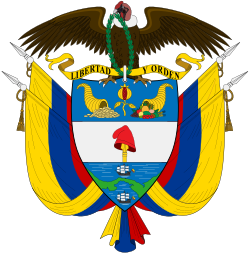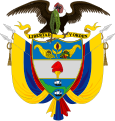
The Viceroyalty of New Granada also called Viceroyalty of the New Kingdom of Granada or Viceroyalty of Santafé was the name given on 27 May 1717 to the jurisdiction of the Spanish Empire in northern South America, corresponding to modern Colombia, Ecuador, Panama and Venezuela. Created in 1717 by King Felipe V, as part of a new territorial control policy, it was suspended in 1723 for financial problems and was restored in 1739 until the independence movement suspended it again in 1810. The territory corresponding to Panama was incorporated later in 1739, and the provinces of Venezuela were separated from the Viceroyalty and assigned to the Captaincy General of Venezuela in 1777. In addition to those core areas, the territory of the Viceroyalty of New Granada included Guyana, Trinidad and Tobago, southwestern Suriname, parts of northwestern Brazil, and northern Peru.

The national flag of Colombia symbolises Colombian independence from Spain, gained on 20 July 1810. It is a horizontal tricolor of yellow, blue and red. The yellow stripe takes up a half of the flag and the blue and red take up a quarter of the space each.

The national flag of Ecuador, which consists of horizontal bands of yellow, blue and red, was first adopted by law in 1835 and later on 26 September 1860. The design of the current flag was finalized in 1900 with the addition of the coat of arms in the center of the flag. Before using the yellow, blue and red tricolor, Ecuador's former flag had three light blue stripes and two white stripes with three white stars for each province of the country.The design of the flag is very similar to those of Colombia and Venezuela, which are also former constituent territories of Gran Colombia. All three are based on a proposal by Venezuelan General Francisco de Miranda, which was adopted by Venezuela in 1811 and later Gran Colombia with some modifications. There is a variant of the flag that does not contain the coat of arms that is used by the merchant marine. This flag matches Colombia's in every aspect, but Colombia uses a different design when her merchant marine ships are at sail.

The national flag of Spain, as it is defined in the Constitution of 1978, consists of three horizontal stripes: red, yellow and red, the yellow stripe being twice the height of each red stripe. Traditionally, the middle stripe was defined by the more archaic term of gualda, and hence the popular name la Rojigualda (red-weld).

The coat of arms of Chile dates from 1834 and was designed by the English artist Charles Wood Taylor (1792–1856). It is made up by a figurative background divided in two equal parts: the top one is blue and the bottom, red. A five pointed white star is in the centre of the shield. This background is supported in one side by a condor, the most significant bird of prey from the Andes, and in the other, by a huemul, a mammal endemic to Chile. Both animals wear golden naval crowns symbolising the heroic deeds of the Chilean Navy in the Pacific Ocean.

The Congress of Angostura was convened by Simón Bolívar and took place in Angostura during the wars of Independence of Colombia and Venezuela, culminating in the proclamation of the Republic of Colombia. It met from February 15, 1819, established the new independent-from-Spain nation on December 17, was interrupted by further independentist activity, and reconvened on July 31, 1821, when the Congress of Cúcuta began its sessions. The Angostura assembly consisted of twenty-six delegates representing Venezuela and New Granada.
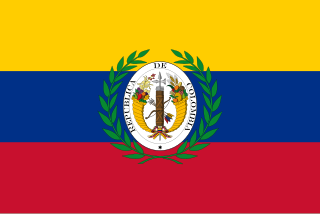
The flag of Gran Colombia was based on Francisco de Miranda's tricolour, which served as the national flag of the First Republic of Venezuela. The general design of the Gran Colombian flag later served as the model for the current flags of Colombia, Ecuador, and Venezuela, which emerged as independent nations at the breakup of Gran Colombia in 1831.
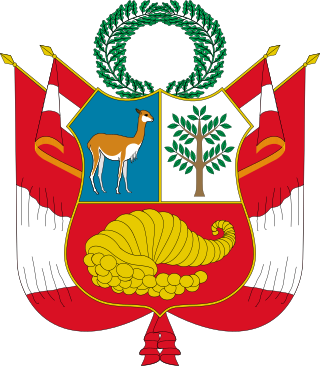
The Coat of arms of Peru is the national symbolic emblem of Peru. Four variants are used: the Coat of arms per se ; the National Coat of arms, or National Shield ; the Great Seal of the State ; and the Naval Coat of arms.

The coat of arms of Haiti is the national coat of arms of the Republic of Haiti. It was originally introduced in 1807, and it has appeared in its current form since 1986. Since this Haitian national symbol does not conform to the rules of heraldry for a traditional coat of arms, then it could be considered a national emblem instead.
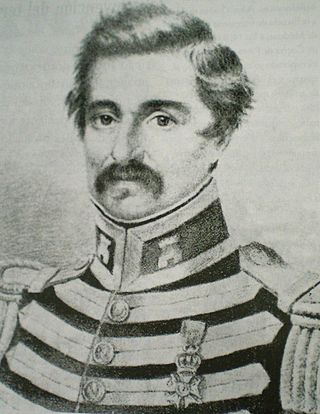
Giovanni Battista Agostino Codazzi was an Italo-Venezuelan soldier, scientist, geographer, cartographer, and governor of Barinas (1846–1847). He made his main investigations and cartographic work in Venezuela and Colombia, thereby creating for both countries a complete set of maps and statistics after the tumultuous years following independence from the Spanish Empire.
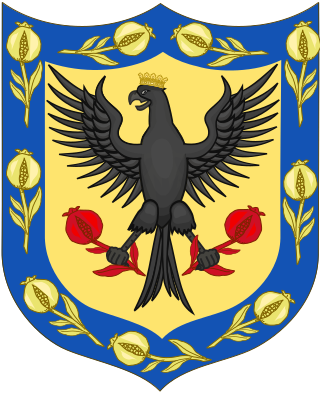
The official coat of arms of the Capital District of Bogotá, the capital of Colombia, was granted by the Emperor Charles V to the New Kingdom of Granada on December 3, 1548 in Valladolid.
Spain has many coats of arms: the nation has one, the reigning monarch and the heir presumptive each have one, and there are others for the institutions of state and for Spanish regions and towns.

The Colombian Declaration of Independence occurred on July 20, 1810 when the Junta de Santa Fe was formed in Santa Fe de Bogota, the capital of the Spanish colonial Viceroyalty of New Granada, to govern the territory autonomously from Spain. The event inspired similar independence movements across Latin America, and triggered an almost decade-long rebellion culminating in the founding of the Republic of Gran Colombia, which spanned present-day Colombia, mainland Ecuador, Panama, and Venezuela, along with parts of northern Peru and northwestern Brazil.

The Coat of arms of the Second Spanish Republic was the emblem of the Second Spanish Republic, the government that existed in Spain between April 14, 1931, when King Alfonso XIII left the country, and April 1, 1939, when the last of the Republican forces surrendered to Francoist forces at the end of the Spanish Civil War.

Manuel del Socorro Rodríguez was a Cuban journalist. He is considered to be the founder of journalism in Colombia. Five years before his arrival in the Viceroyalty of New Granada, the 1785 Viceroyalty of New Granada earthquake had happened, described in the Aviso del Terremoto and published the day of the earthquake. This sparked the birth of journalism in Colombia, when Del Socorro started to report in 1791.

Manuel María Paz Delgado was a Colombian cartographer, military officer, artist and watercolorist.

Italian Colombians are Colombian-born citizens who are fully or partially of Italian descent, whose ancestors were Italians who emigrated to Colombia during the Italian diaspora, or Italian-born people in Colombia. Italians have been immigrating to Colombia since the early 16th century.

The flag of Tuscany is the official flag of the region of Tuscany, Italy. The flag depicts a silver Pegasus rampant on a white field between two horizontal red bands. The flag first appeared as a gonfalon on 20 May 1975 along with accompanying text Regione Toscana above the Pegasus. It was officially adopted as the flag of Tuscany on 3 February 1995.

The coat of arms of Gran Colombia was adopted in 1821.
